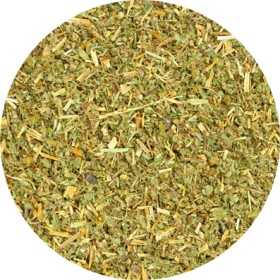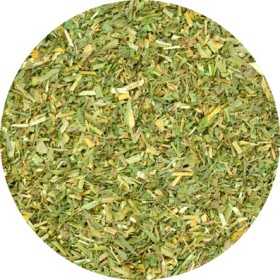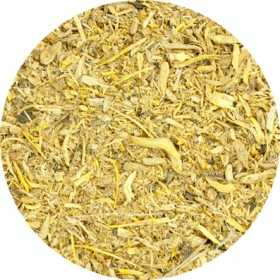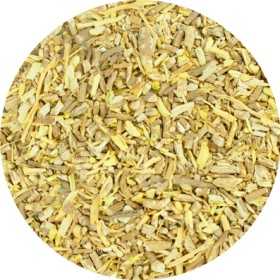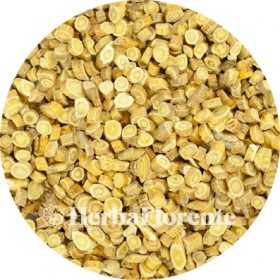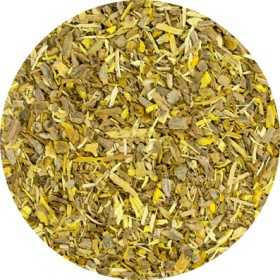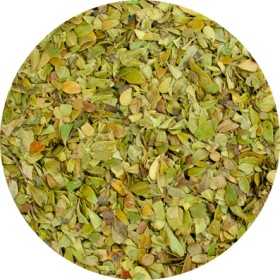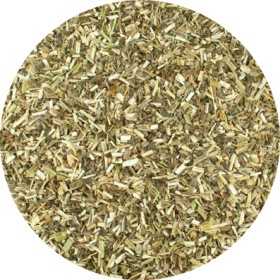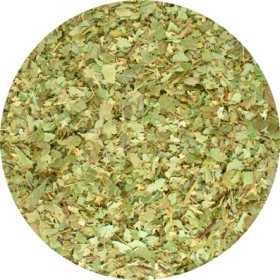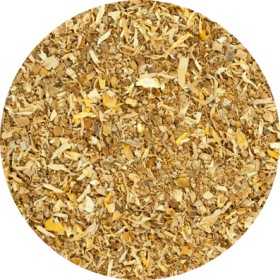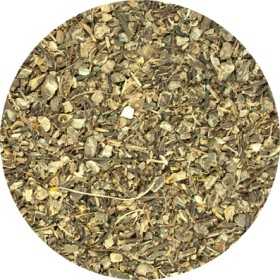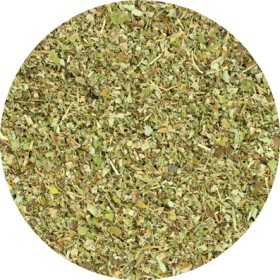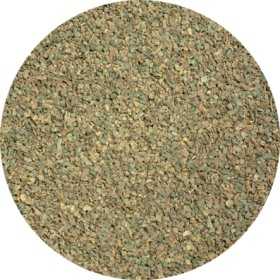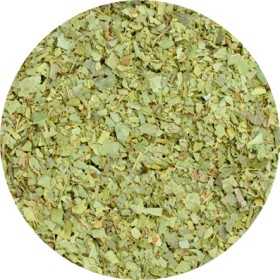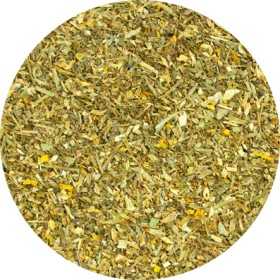English name
There are 119 products.
Agremonie (Common) (Church Steeples) - Agrimonia eupatoria
The common agrimony (Agrimonia eupatoria) is a herbaceous plant belonging to the rose family (Rosaceae). This plant, with its bright yellow flowers in long, slender spikes, is quite common on calcareous roadsides and dikes in Belgium and the Netherlands.
In herbal medicine, this plant is used for various purposes due to its active constituents, including triterpenes, tanning and bitter substances, flavonoids, silicic acid and mucilages.
The most common use is as a tea, but the herb can also be made into a tincture.
In herbal medicine, this plant is used for various purposes due to its active constituents, including triterpenes, tanning and bitter substances, flavonoids, silicic acid and mucilages.
The most common use is as a tea, but the herb can also be made into a tincture.
€2.00
From: €2.00
Alfalfa - Medicago sativa
Lucerne (Medicago sativa), also known as alfalfa, is a perennial plant that can live between five and twelve years, depending on the variety and climate. With a height of up to one meter and clusters of small purple flowers, the plant resembles clover. The plant has a deep and powerful root system that can extend up to 4.5 meters.
Lucerne is native to Europe and is grown worldwide as animal feed. In the Netherlands, alfalfa is mainly dried artificially for the production of protein-rich animal feed.
Lucerne is native to Europe and is grown worldwide as animal feed. In the Netherlands, alfalfa is mainly dried artificially for the production of protein-rich animal feed.
€2.00
From: €2.00
American Skullcap - Scutellaria lateriflora
Skullcap (Scutellaria) is a versatile genus of both annual and perennial plants, belonging to the Lamiaceae family. The genus includes about two hundred species, all of which are characterized by their characteristic, calyx-shaped flowers. These flowers are distinguished by clearly visible upper and lower lips. The name "Scutellaria" is derived from the Latin word "scutella", which means "small shield" or "saucer", and refers to the shape of the calyx.
€6.25
From: €6.25
Angelica - Angelica angelicae
The angelica (Angelica archangelica), also known as archangelica, belongs to the umbellifer family (Apiaceae). This plant thrives in moist, very nutrient-rich soil along water edges, such as the IJsselmeer, river banks and in osier banks. In addition, the angelica is also grown in gardens.
Historically, angelica is known for its medicinal properties. The plant is still grown locally from central Germany to Turkestan. A sweet-smelling oil known as angelica oil is extracted from the seeds and roots, which is used in the cosmetic industry, liquor distilleries and bakeries. In addition, the stems and petioles are often candied because of their sweet and fragrant taste.
Historically, angelica is known for its medicinal properties. The plant is still grown locally from central Germany to Turkestan. A sweet-smelling oil known as angelica oil is extracted from the seeds and roots, which is used in the cosmetic industry, liquor distilleries and bakeries. In addition, the stems and petioles are often candied because of their sweet and fragrant taste.
€2.60
From: €2.60
Artichoke - Cynaria scolmycus - Cut
The artichoke (Cynara scolymus) is a plant that originates from the Mediterranean region. People eat the closed green or purple flower buds as vegetables. The artichoke leaf has a slightly bitter taste. This plant has been consumed for centuries for the support it provides to digestion and the cleansing effect of the liver, thanks to its high concentration of antioxidants.
The artichoke is rich in various nutrients and phytonutrients. It contains beta-carotene, vitamin C, vitamin B, and minerals such as calcium, magnesium and potassium. It also contains flavonoids, enzymes and tannins.
The artichoke is rich in various nutrients and phytonutrients. It contains beta-carotene, vitamin C, vitamin B, and minerals such as calcium, magnesium and potassium. It also contains flavonoids, enzymes and tannins.
€2.00
From: €2.00
Ashwagandha - Withania somnifera - Cut
In Ayurvedic medicine, ashwagandha is known as a 'rasayana', meaning it is used to support both physical and mental health. It has a calming effect and is used to sleep better and promote a balanced mind. In India, where this herb originates, it is believed to support male potency and female health, often compared to the strength and vitality of a horse.
€3.00
From: €3.00
Asian Pennywort (Gotu kola) - Hydrocotyles Folium (Centella asiatica)
Asian pennywort also known as Gotu kola(Centella asiatica), is a plant that thrives in Southeast Asia and plays a central role in Ayurvedic medicine. Due to its diverse active substances, Asian pennywort is widely used in herbal medicine. It is known for supporting cognitive functions such as memory, concentration and learning, and it is also used to promote healthy blood circulation and vascular function.
Asian pennywort is a delicate plant with creeping stems and small, rounded leaves, often accompanied by white or pink flowers. The main bioactive compounds in Asian pennywort are triterpene glycosides, alkaloids and essential oils.
Asian pennywort is a delicate plant with creeping stems and small, rounded leaves, often accompanied by white or pink flowers. The main bioactive compounds in Asian pennywort are triterpene glycosides, alkaloids and essential oils.
€3.50
From: €3.50
Astragalus - Astragalus chinensis membranus - Cut
Astragalus, also known as Fleshy Locust (Astragalus membranaceus), is a plant native to Asia. It has been used for 2000 years in traditional Chinese herbal medicine to strengthen the immune system. In addition to this property, astragalus has many other benefits. According to Chinese tradition, it strengthens the life force, or 'qi', as it is called in China, when ingested. It is known as a powerful antioxidant and is especially valued for its ability to support the immune system.
€2.60
From: €2.60
Barberry - Berberidi vulgaris
The barberry (Berberis vulgaris) is a shrub belonging to the barberry family (Berberidaceae) and native to Eurasia.
The entire plant, including the fruits and seeds, contains berberine.
The shrub grows on fairly dry, usually calcareous soil along thickets and forest edges.
Traditionally, the vitamin C-rich berries were used in Europe for making jam. In countries such as Iran, the fruits are used as a seasoning in rice dishes, fish and meat.
The entire plant, including the fruits and seeds, contains berberine.
The shrub grows on fairly dry, usually calcareous soil along thickets and forest edges.
Traditionally, the vitamin C-rich berries were used in Europe for making jam. In countries such as Iran, the fruits are used as a seasoning in rice dishes, fish and meat.
€2.00
From: €2.00
Bearberry - Arctostaphylos uva-ursi - Cut
The bearberry (Arctostaphylos uva-ursi) is a plant from the heather family (Ericaceae). The Dutch name "bearberry" refers to the assumption that bears would be fond of the fruits of this plant.
The scientific name Arctostaphylos uva-ursi is a tautological mixture of Greek and Latin. The Greek 'arktos' and the Latin 'ursus' both mean "bear", while 'staphyle' and 'uva' both mean "grape".
This plant is known for its supportive effect on the urinary tract. As early as the thirteenth century, bearberry was mentioned in herbal books and praised for its beneficial effects on the bladder.
The scientific name Arctostaphylos uva-ursi is a tautological mixture of Greek and Latin. The Greek 'arktos' and the Latin 'ursus' both mean "bear", while 'staphyle' and 'uva' both mean "grape".
This plant is known for its supportive effect on the urinary tract. As early as the thirteenth century, bearberry was mentioned in herbal books and praised for its beneficial effects on the bladder.
€2.40
From: €2.40
Betony - Wood Betony - Betonica officinalis
Betony (Betonica officinalis, synonym: Stachys officinalis) is a herbaceous plant from the Lamiaceae family. In the Netherlands and Belgium, the species is on the Red List of plants, where it is classified as very rare and has declined sharply in numbers. In addition to its natural occurrence, betony is also often cultivated as an ornamental plant.
The plant reaches a height of 30–90 cm and blooms from June to August with purple-red flowers, although white varieties sometimes occur. The flowers are in dense, spike-shaped false inflorescences. Most leaves form a basal rosette: the lower leaves have long petioles, while the upper leaves have short petioles. All leaves have a reticulate venation. The stem is unbranched, square in shape and covered with short hairs.
The plant reaches a height of 30–90 cm and blooms from June to August with purple-red flowers, although white varieties sometimes occur. The flowers are in dense, spike-shaped false inflorescences. Most leaves form a basal rosette: the lower leaves have long petioles, while the upper leaves have short petioles. All leaves have a reticulate venation. The stem is unbranched, square in shape and covered with short hairs.
€3.20
From: €3.20
Birch - Betula pendula Roth, Betulae (Leaf Cut)
The Birch (Betula) has been valued for centuries for its beneficial properties, thanks to the presence of bioactive substances. In the past, it was even considered a sacred tree. In the spring, just before the tree starts to leaf out, birch sap is tapped because the sap flow is strongest then. This sap is full of phytonutrients, minerals and vitamins. The young leaves are then collected, because they also contain a high content of various beneficial substances during this period.
Birch leaf is rich in flavonoids, saponins and tannins. The saponins and tannins are responsible for the diuretic properties of the birch.
Birch leaf is rich in flavonoids, saponins and tannins. The saponins and tannins are responsible for the diuretic properties of the birch.
€2.10
From: €2.10
Birch - Butla alba, Betulae (Bark Cut)
Birch (Betula) has been valued for centuries for its beneficial properties, thanks to the presence of bioactive substances. In the past it was even considered a sacred tree. In the spring, just before the tree sprouts, birch sap is tapped because that is when the sap flow is strongest. This juice is full of phytonutrients, minerals and vitamins.
Birch is rich in flavonoids, saponins and tannins. The saponins and tannins are responsible for the diuretic properties of the birch. Birch supports, among other things, kidney function and a healthy urinary tract, and is beneficial for the liver. In addition, it promotes joint health and contributes to maintaining normal cholesterol levels.
Birch is rich in flavonoids, saponins and tannins. The saponins and tannins are responsible for the diuretic properties of the birch. Birch supports, among other things, kidney function and a healthy urinary tract, and is beneficial for the liver. In addition, it promotes joint health and contributes to maintaining normal cholesterol levels.
€2.00
From: €2.00
Black Cohosh - Cimicifuga Racemosa
Black cohosh (Cimicifuga racemosa), has been used in North American herbal medicine for centuries. The roots of this plant have been used for centuries by northern Indian tribes, where it is known as "squawroot" (where 'squaw' refers to 'Indian woman'). Black cohosh is best known as an herb specifically aimed at women and is becoming increasingly popular in the Netherlands. It provides support for menopausal symptoms such as hot flashes and irritable feelings.
€9.80
From: €9.80
Black Tea Assam - Camellia sinensis
Black Tea Assam is a black tea from the state of the same name in India. Since 1838, this tea has also been drunk outside India, but in the first 25 years it could not compete with the already popular Japanese and Chinese teas, which had been popular in Europe since the 17th century. Today, about half of the total Indian tea production comes from Assam, making this region more popular than the other famous Indian teas: Darjeeling and Nilgiri.
€2.95
From: €2.95
Black Walnut - Juglandis nigrum
The shell of the black walnut (Juglans nigra) comes from the immature fruits of the black walnut tree (Juglans nigra).
Black walnut (Juglans nigra, also known as 'black nut') is a species of walnut that grows naturally only in the United States and Canada, hence the term American black walnut. Juglans nigra belongs to the walnut family.
The fruits are dark brown and have a strong odor distinct from European walnuts. In America, the use of black walnut has long been common among herbalists. It is often used in the form of an extract or tincture in herbal medicine, because this way the active substances are optimally preserved. The fruits are edible and contain polyphenols, tannins, juglon, tannins and omega fatty acids.
Black walnut (Juglans nigra, also known as 'black nut') is a species of walnut that grows naturally only in the United States and Canada, hence the term American black walnut. Juglans nigra belongs to the walnut family.
The fruits are dark brown and have a strong odor distinct from European walnuts. In America, the use of black walnut has long been common among herbalists. It is often used in the form of an extract or tincture in herbal medicine, because this way the active substances are optimally preserved. The fruits are edible and contain polyphenols, tannins, juglon, tannins and omega fatty acids.
€2.50
From: €2.50
Blackberry (Leaf) - Rubus fructicosus, Frucus Rubi
The genus Blackberry (Rubus) belongs to the rose family and has more than 1400 species worldwide. More than 200 of these species grow in the Netherlands and Belgium.
Blackberries are prized primarily for their fruits, which range in color from red to dark blue. They have a sweet taste and can be eaten fresh or processed into jam, for example.
The leaves of the blackberry can be used to make herbal tea. After picking, the leaves should be dried in a dry and airy place, after which they can be used to make tea.
Blackberries are prized primarily for their fruits, which range in color from red to dark blue. They have a sweet taste and can be eaten fresh or processed into jam, for example.
The leaves of the blackberry can be used to make herbal tea. After picking, the leaves should be dried in a dry and airy place, after which they can be used to make tea.
€2.00
From: €2.00
Blackcurrant - Ribes nigrum
The Latin name for blackcurrant is Ribes nigrum L. 'Nigrum' refers to the dark color and 'ribes' to the berries themselves. Various parts of the blackcurrant plant are attributed with different health benefits. The berries, seeds and leaves exhibit unique properties. For example, blackcurrant leaves are used to maintain healthy cartilage and to keep the joints flexible.
€2.95
From: €2.95
Bladderwrack Fine - Fucus vesiculosus
Bladderwrack (Fucus vesiculosus) is a type of brown algae belonging to the genus Fucus. It thrives along the northern coasts of the Atlantic and Pacific Oceans, and in the North Sea and Baltic Sea, often found in kelp forests. This seaweed is characterized by air bladders that serve as a floating organ, although there are also variants without these bladders.
Like other brown algae, bladderwrack is rich in a specific class of polyphenols called phlorotannins, which possess powerful antioxidant properties. In addition, these phlorotannins have antibiotic, antifungal and anti-inflammatory properties.
Like other brown algae, bladderwrack is rich in a specific class of polyphenols called phlorotannins, which possess powerful antioxidant properties. In addition, these phlorotannins have antibiotic, antifungal and anti-inflammatory properties.
€2.50
From: €2.50
Blessed Thistle - Centaurea benedicta
Centaurea benedicta, commonly known as St. Benedict's Thistle, blessed thistle, holy thistle, spotted thistle or dissolved knapweed, is a thistle-like plant belonging to the family Asteraceae. Originally native to the Mediterranean region, it ranges from Portugal and southern France to Iran. Outside its native habitat it is often found as a systematic species and in some regions such as North America it is observed as a conventional weed.
This annual plant grows up to 60 cm tall and has leathery, hairy leaves that can reach 30 cm long and 8 cm wide.
This annual plant grows up to 60 cm tall and has leathery, hairy leaves that can reach 30 cm long and 8 cm wide.
€2.25
From: €2.25
Boldoblad - Peumus boldus
Boldo (Peumus Boldus) is a versatile plant with a long history of positive effects on the liver, bile and digestion. It contains a combination of alkaloids, essential oils, flavonoids and tannins, which together provide these beneficial properties. By supporting the liver and bile and promoting healthy digestion, boldo is a valuable addition to a healthy lifestyle. In addition, boldo strengthens the immune system and acts as a powerful antioxidant.
€2.00
From: €2.00
California Poppy - Eschscholzia californica
California Poppy, also known as golden poppy (Eschscholtzia californica), is a plant with golden yellow flowers that belongs to the poppy family. It owes this name to its soothing properties, which help with natural, healthy sleep and stress reduction.
This plant is native to California, hence the name. The indigenous people of America traditionally used golden poppy as a sedative herb and to help them sleep better. The aerial parts of the golden poppy contain several active substances, including quinolide alkaloids, rutin, phytosterols, carotenoids and cyanogen glycosides.
This plant is native to California, hence the name. The indigenous people of America traditionally used golden poppy as a sedative herb and to help them sleep better. The aerial parts of the golden poppy contain several active substances, including quinolide alkaloids, rutin, phytosterols, carotenoids and cyanogen glycosides.
€2.00
From: €2.00
Cat's Claw - Uncaria tomentosa - Cut
Cat's claw (Uncaria tomentosa) is a climbing plant that is native to the Amazon region of Brazil and Peru. It is highly valued in the Peruvian Amazon and is among the protected species. This plant is often called the 'sacred herb of the rainforest' because of its significance. The name 'cat's claw' or 'cat's claw' is derived from the small claw-like thorns at the base of the leaves, which resemble a cat's claws. These claws help the vine to wrap itself around trees and climb up to a hundred meters high!
€2.20
From: €2.20
Catnip - Nepetae catariae
Wild catnip (Nepeta cataria) belongs to a genus of 250 species in the family Lamiaceae. The genus is closely related to Glechoma, Stachys and Prunella. This genus originally occurs in Europe and Asia. The stems grow in nodes and often form dense carpets on the ground. The leaves are coarsely toothed and feel soft because of the hairs. The erect stems bear small, tubular flowers in pairs that are located in the axils of the leaves.
€2.20
From: €2.20















